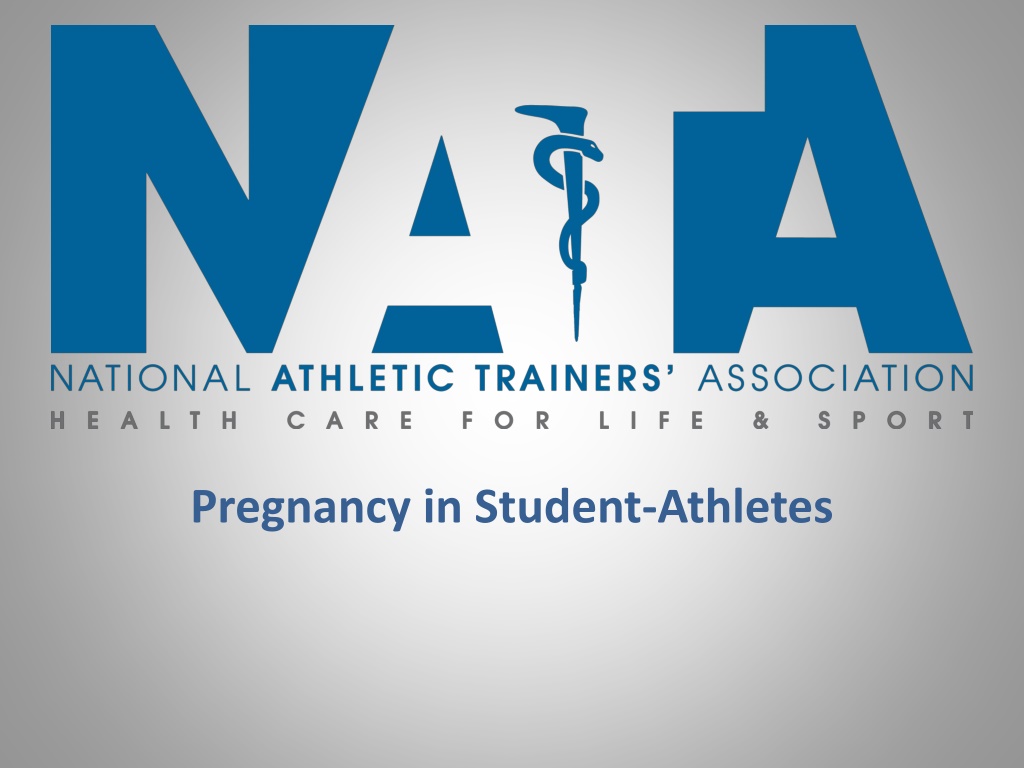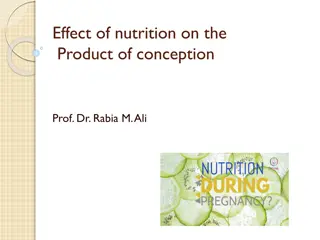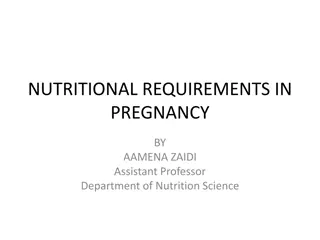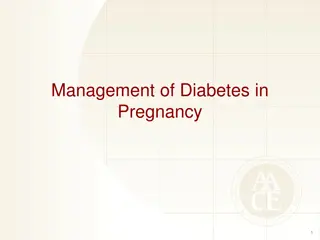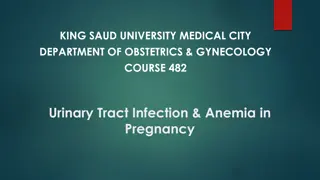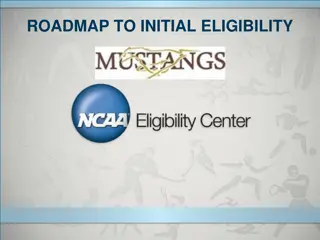Pregnancy Guidelines for Student-Athletes
Guidelines for student-athletes regarding pregnancy include assessing risks of intense physical activity, individualized management, benefits of exercise during pregnancy, risks to consider, access to medical care, NCAA rules on eligibility extension, legal aspects, and exercise modifications based on pregnancy stages.
Download Presentation

Please find below an Image/Link to download the presentation.
The content on the website is provided AS IS for your information and personal use only. It may not be sold, licensed, or shared on other websites without obtaining consent from the author.If you encounter any issues during the download, it is possible that the publisher has removed the file from their server.
You are allowed to download the files provided on this website for personal or commercial use, subject to the condition that they are used lawfully. All files are the property of their respective owners.
The content on the website is provided AS IS for your information and personal use only. It may not be sold, licensed, or shared on other websites without obtaining consent from the author.
E N D
Presentation Transcript
Exercise in Pregnancy A policy must be in place to handle a pregnant student- athlete, and should include: Assessing the risk of intense, strenuous physical activity is difficult Individualized management essential Some evidence showing women who exercise during pregnancy have improved cardiovascular function, limited weight gain and fat retention, improved attitude and mental state, easier and less complicated labor, and enhance postpartum recovery No evidence showing that increased activity increases the risk of spontaneous abortion Theoretical risks exists: increased core body temperature, especially in the heat. Risk of trauma to the fetus in second and third trimester Where the student-athlete can receive confidential counseling Where the student-athlete can access timely medical and obstetrical care How the pregnancy may affect the student- athlete s team standing and institutional grants-in-aid That NCAA rules permit a one-year extension of the five-year period of eligibility for a female student-athlete for reasons of pregnancy. Pregnancy should be treated as any other health condition regarding receipt of grants- in-aid. per bylaw 15.3.4.3
Legal Aspects Title IX regulations prohibit pregnancy discrimination Institutions must treat pregnancy in the same way as they treat any other temporary disability Institution cannot exclude athlete from sports participation, but can require certification from her treating physician Mandatory reporting is discouraged
Exercise Modifications In early pregnancy, athletics poses a low risk Participation status should be dictated by the movements and physical demands required to compete in that sport and the previous activity level of the athlete After the 14th week, Valsalva straining and exercising in supine position may cause venous obstruction and conditioning or training exercises in the position should be avoided Sports with increased incidences of bodily contact or falling are considered high-risk after the first trimester because of potential risk of abdominal trauma Basketball Ice hockey Field hockey Lacrosse Soccer Rugby Gymnastics Equestrian Downhill Skiing
Exercise Prescription Need to modify exercise prescription for pregnant female if considering contact sports or at-risk situations (altitude, diving ) Variable heart rate response to exercise when pregnant; thus caution when using target heart rate for pregnant athlete. Rate of perceived exertion scale may be better Avoid scuba diving, avoid exercise above 2500 meters altitude
Musculoskeletal Adaptations Regular exercise promoted for overall health benefits Weight gain during pregnancy increases forces across joints, increases ligamentous laxity Lumbar lordosis; low back pain Balance changes Despite theoretical risks; no data regarding an increased injury rate during pregnancy
Nutritional Requirements During pregnancy need additional 300 kcal of energy per day after 13th week of pregnancy, even more if exercising Pregnant women use carbohydrate at a greater rate at rest and during exercise than non-pregnant
The American College of Obstetrics and Gynecology states: competitive athletes can remain active during pregnancy but need to modify their activity as medically indicated and require close supervision. A student-athlete choosing to compete while pregnant should : Be made aware of the potential risks of her particular sport and exercise in general while pregnant Be encouraged to discontinue exercise when feeling over- exerted or when any warning sign are present Follow the recommendations of her obstetrical provider in coordination with the team physician Take care to remain well-hydrated and to avoid overheating
Effect of Pregnancy on Competition Weight gain Ability to stop/start Decrease in efficiency of finely tuned skill movement increased injury risk? Anemia change in performance Fluid shifts / concerns Thermoregulatory concerns
Air Travel Commercial air travel; no significant risk Problematic if severe anemia, sickle cell, clotting disorder, platelet insufficiency Safest time to travel; 2nd trimester (8-24 weeks; lowest risk for premature labor) Avoid after 36 weeks or if preterm delivery risk Frequent ambulation, wearing compression stockings, adequate hydration encouraged to minimize blood clot risks
Institutional Policy on the Pregnant Student-Athlete Insert specific institutional policy here
Warning Signs to Terminate Exercise While Pregnant Vaginal Bleeding Shortness of Breath Before Exercise Dizziness Headache Chest Pain Calf Pain or Swelling Pre-term Labor Decreased Fetal Movement Amniotic Fluid Leakage Muscle Weakness
